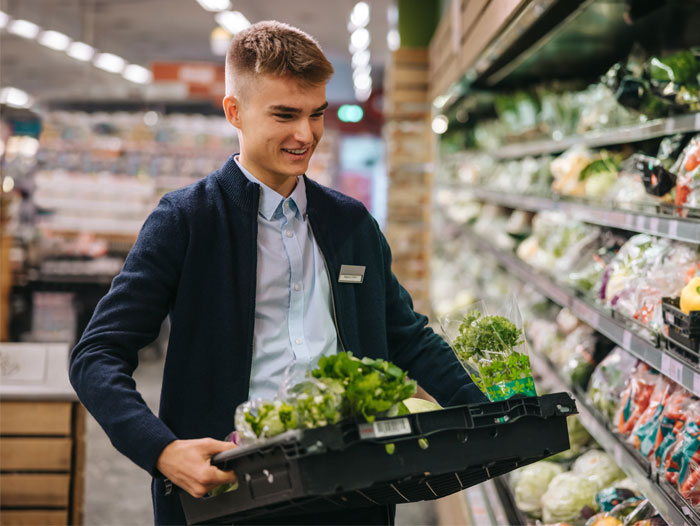4 Fresh Produce Applications Where Retail-Ready Packaging Is Gaining Ground
April 28, 2021 | 4 min to read

CLEVELAND — A new Freedonia Group analysis projects retail-ready boxes to be one of the fastest growing packaging types used in the fresh produce industry through 2024, with the strongest increases anticipated in the $3.5 billion fresh vegetable and salad packaging market.
Though traditional corrugated boxes will remain the dominant box types used in fresh vegetable and salad applications, retail-ready boxes continue to increase their share of demand based on their added convenience – providing the benefits of prepackaged produce for retailers, along with the selection of bulk produce bins, which consumers often prefer. Highlighted below are four key produce applications where use of these value-added boxes is growing.
Tomatoes Will Remain the Largest Market for Retail-Ready Produce Boxes
Tomatoes will remain by far the largest application for retail-ready boxes used in fresh vegetable applications and comprise the largest single share of sales gains through 2024, growing 5.0% annually. Modular retail-ready boxes are often preferred in these applications because they showcase the tomatoes and feature attractive graphics.
Salad Continues to Be Key Outlet for Retail-Ready Boxes
Though much smaller than the tomato market, salad will remain the second leading market for retail-ready boxes, with 5.5% annual growth anticipated through 2024, as use of retail-ready packaging increases with bagged salad mixes, as well as salads packaged in clamshells or other plastic containers.
Penetration Increases in the Potato Market
Though also from a small base compared to tomatoes, demand for retail-ready boxes in the sizable potato packaging market is forecast to rise 5.4% per year through 2024, as use of retail-ready boxes expands for both loose and bagged potatoes.
Fastest Growth Expected for Smaller Volume Vegetables
The fastest growth in retail-ready box demand is expected for carrots, mushrooms, onions, and smaller volume vegetables such as sweet potatoes, bolstered by the increasing popularity of modular produce boxes in these applications due to their convenience. Though from a small bases, retail-ready box sales in these applications is projected to exceed 6% annually through 2024, with double-digit percentage growth expected for mushrooms.
Looking for More about the Fresh Vegetable & Salad Packaging Market?
Fresh Vegetable & Salad Packaging is now available from the Freedonia Group.
This study analyzes the US market for fresh vegetable and salad packaging (i.e., fresh, minimally processed vegetables, as well as salad mixes and fresh-cut vegetables). Historical data (2009, 2014, and 2019) and forecasts for 2024 are presented for produce packaging demand in current US dollars (including inflation) by product and application.
Demand is also discussed by four material categories – plastic, paper and paperboard, molded pulp, and other materials (e.g., cotton mesh, foil wrap, plastic mesh, wood, textiles).
Specific products covered include the following:
- retail-ready and other corrugated boxes (regular slotted containers, full telescoping boxes, boxes with cut-outs for display purposes, open-top tray-style boxes, fold-over gift boxes, bulk bins)
- bags, including bag liners (e.g., plastic mesh, paper, textile)
- plastic containers (clamshells, tubs, cups, bowls, square &and rectangular two-piece containers, and pails, domed containers, lidded buckets)
- pouches (pillow and stand-up)
- trays and platters (including molded pulp, rigid plastic, expanded polystyrene foam, and paperboard types)
- other packaging (e.g., baskets, punnets, and tills; reusable plastic containers; plastic film; foam boxes; wood crates; folding cartons; sleeves; etc.)
For products packaged in combination-type formats – such as a tray of peppers enclosed in a pillow pouch – the value of each type of packaging is counted separately and included within each respective product segment.
Fresh vegetable and salad packaging demand is also discussed by application:
- salad
- tomatoes
- potatoes
- onions
- lettuce
- carrots
- mushrooms
- celery
- cabbage
- peppers
- other vegetables (e.g., asparagus, beets, broccoli, Brussels sprouts, cauliflower, cucumbers, eggplant, garlic, kale, spinach, squash, sweet corn, sweet potatoes, yams, zucchini)
Furthermore, demand is examined by format: ready-to-eat and all other formats.
About the Freedonia Group – The Freedonia Group, a division of MarketResearch.com, is the premier international industrial research company, providing our clients with product analyses, market forecasts, industry trends, and market share information. From one-person consulting firms to global conglomerates, our analysts provide companies with unbiased, reliable industry market research and analysis to help them make important business decisions. With over 100 studies published annually, we support over 90% of the industrial Fortune 500 companies. Find off-the-shelf studies at https://www.freedoniagroup.com/ or contact us for custom research: +1 440.842.2400.
